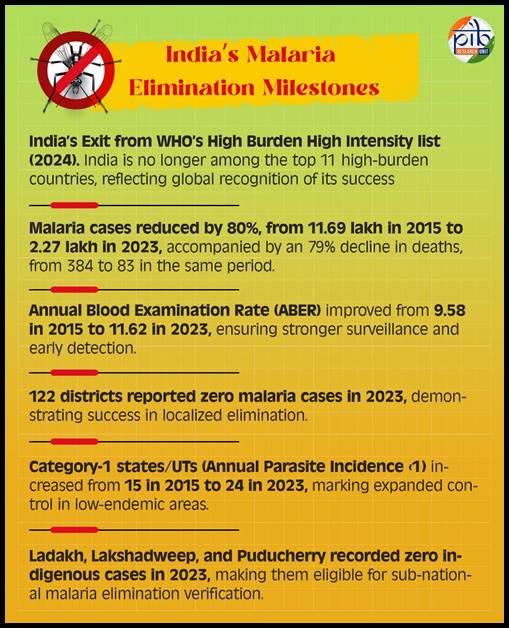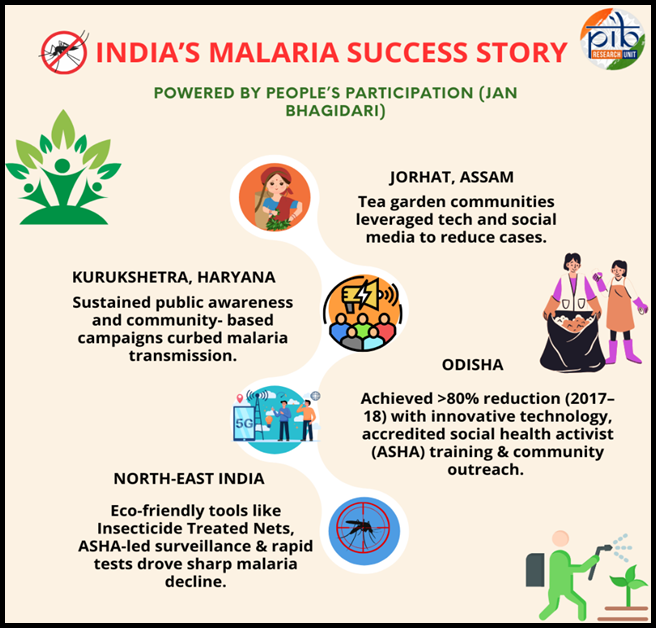Ministry of Health and Family Welfare
World Malaria Day – 2025
Towards a Malaria-Free India
प्रविष्टि तिथि:
25 APR 2025 5:29PM by PIB Delhi
|
“Malaria has been a big challenge confronting humanity for four thousand years. Even at the time of Independence, it was one of our biggest health challenges. Today, I can say with satisfaction that the countrymen have collectively, strongly fought this challenge.”
- Prime Minister, Shri Narendra Modi
|
|
Summary
- World Malaria Day is observed globally every year on 25th April.
- With an 80.5% decline in Malaria cases, between 2025-2023, India exited WHO’s High Burden to High Impact (HBHI) group in 2024, marking a global milestone.
- Malaria deaths declined by 78.38% between 2015 and 2023.
- 122 districts reported zero malaria cases in 2023, showing strong localized impact.
- Intensified Malaria Elimination Project (IMEP) -3 targets 159 high-burden districts to accelerate malaria elimination in vulnerable areas.
- The nationwide “Test, Treat, Track” strategy ensures early detection and timely treatment.
- India aims to achieve zero indigenous malaria cases by 2027 and full elimination by 2030.
|
World Malaria Day is observed globally on 25th April each year, following its institution by the World Health Organisation’s (WHO) member states during the 2007 World Health Assembly. The theme for 2025, “Malaria Ends With Us: Reinvest, Reimagine, Reignite,” calls for renewed global commitment to end malaria through innovation, collaboration, and sustained action.
Once among the world’s highest malaria-burdened countries, India has demonstrated remarkable progress through sustained political will, grassroots participation, and targeted interventions. A defining milestone came in 2024, when India exited the WHO’s High Burden to High Impact (HBHI) group—
signalling a paradigm shift in the country’s malaria trajectory. Backed by the National Framework for Malaria Elimination (2016–2030) and the National Strategic Plan (2023–2027), India has aligned its strategy with global standards while tailoring solutions to local needs.
With an 80.5% reduction in malaria cases and 78.3% reduction in deaths between 2015 and 2023, and over 122 districts reporting zero cases last year, the country is advancing with renewed momentum towards achieving zero indigenous cases by 2027 and setting a global benchmark in public health elimination efforts. India reaffirms its steadfast commitment to eliminating malaria by 2030.


Overview of Malaria
What is Malaria? How does it occur?
|
Malaria is a life-threatening disease caused by parasites and spread to humans through the bites of infected female Anopheles mosquitoes. It is common in tropical regions, but is preventable and treatable. Malaria does not spread from person to person, though it can also be transmitted through infected blood or contaminated needles. If left untreated, especially in cases of Plasmodium falciparum infection, it can lead to severe illness or even death within 24 hours.
|
What are its symptoms?
|
The most common early symptoms of malaria include fever, headache, and chills, usually appearing 10–15 days after being bitten by an infected mosquito. Symptoms may be mild, especially in people who’ve had malaria before, making early testing essential for timely treatment. Severe symptoms can include extreme fatigue, confusion, repeated seizures, breathing difficulties, dark or bloody urine, jaundice, and abnormal bleeding. Some types of malaria can cause severe illness and death.
|
How can it be prevented?
|
Malaria can be prevented by avoiding mosquito bites and, in some cases, by taking preventive medicines. If you're travelling to areas where malaria is common, consult a doctor about taking preventive drugs (chemoprophylaxis) in advance. To lower the risk of mosquito bites, use mosquito nets while sleeping, especially in areas where malaria is present. Apply mosquito repellents that contain DEET, IR3535, or Icaridin after dusk. You can also use coils, vaporizers, and window screens to keep mosquitoes away. Wearing long-sleeved clothing in the evenings helps protect exposed skin.
|
How can it be treated?
|
Early diagnosis and treatment are key to curing malaria and stopping its spread. Anyone with symptoms should get tested using microscopy or a rapid diagnostic test. Malaria is a serious illness that always requires treatment with medicine. The type of medicine used depends on the type of malaria parasite, the person's age, weight, whether they are pregnant, and if the parasite is resistant to certain drugs. The most effective treatment for Plasmodium falciparum is Artemisinin-based combination therapy (ACTs). Chloroquine is used to treat Plasmodium vivax in areas where it is still effective. Primaquine is added to prevent relapses in P. vivax and P. ovale cases. Most treatments are given in pill form, but people with severe malaria may need to be treated with injectable medicines at a hospital or health centre.
|
Global Burden of Malaria
|
According to the World Malaria Report, the estimated number of malaria deaths stood at 5 lakhs 97 thousand in 2023, compared to 6 lakhs in 2022.
|
|
In 2023, the 11 HBHI countries were responsible for 66% of global malaria cases and 68% of deaths.
|
India’s Commitment and National Goals
India remains steadfast in its commitment to eliminate malaria by 2030, with the intermediate target of zero indigenous cases by 2027. The strategic roadmap for this mission is guided by:
- The National Framework for Malaria Elimination in India (2016–2030) outlines the vision, goals, and targets for phased malaria elimination.
- The recently launched National Strategic Plan for Malaria Elimination (2023–2027) builds upon earlier frameworks and aligns with the WHO Global Technical Strategy for Malaria 2016–2030.
Key Interventions and Strategic Approach by the Government for Malaria Control
To translate its malaria elimination vision into actionable outcomes, India has adopted a comprehensive, evidence-driven strategy. This approach integrates disease management, vector control, and community-driven interventions to ensure lasting impact and inclusive health coverage.
Strategies for elimination of Malaria:
- Malaria surveillance as a core intervention for malaria elimination.
- Ensuring universal access to malaria diagnosis and treatment by enhancing and optimizing case management -“testing, treating and tracking”.
- Ensuring universal access to malaria prevention by enhancing and optimizing vector control
- Accelerating efforts towards elimination and attainment of malaria –free status.
- Promoting research and supporting the generation of strategic information for malaria elimination and prevention of re-establishment of malaria transmission.
Other Supportive Interventions
- Behaviour Change Communication (BCC) for community mobilization. This includes mass media campaigns, community engagement, and leveraging local influencers.
- Inter-sectoral convergence involving various ministries and stakeholders to address the socio-economic and environmental determinants of malaria.
- Capacity building: Over 850 health professionals trained in 2024 and conducting studies on insecticide resistance and therapeutic efficacy.
- The National Framework for Malaria Elimination (NFME) 2016–2030 categorizes regions by malaria prevalence, with Category 3 – Intensified Control Phase targeting high-burden areas. This phase focuses on aggressive disease control, district-level planning, and specific strategies for P. vivax, supported by robust systems and resources to move towards elimination.
- Intensified Malaria Elimination Project-3 (IMEP-3) targets 159 high-burden districts across 12 states, focusing on malaria-prone and vulnerable populations to accelerate elimination efforts.
- Funding supports key interventions such as LLIN distribution, entomological surveillance, and data-driven monitoring systems to ensure sustained impact.
- Integration of malaria services under Ayushman Bharat and delivery through Ayushman Arogya Mandirs and Community Health Officers.

Prime Minister Shri Narendra Modi had lauded the community-led malaria control as a key driver in the 117th edition of the Mann Ki Baat programme on 29th December, 2024. These examples highlight the power of grassroots action in achieving a malaria-free India.
Conclusion
On World Malaria Day, India stands at a defining moment in its public health journey, transforming from a high-burden nation to a global exemplar in malaria control. This progress has been made possible through science-led strategies, resilient health systems, and the power of people’s participation. As the nation advances towards eliminating indigenous malaria by 2027 and achieving full eradication by 2030, the call to action is clear: we must reinvest in innovation, reimagine community partnerships, and reignite collective resolve. Under the banner of “Malaria Ends With Us” every effort counts—because a malaria-free India is not just a goal, but a shared responsibility.
References
Click here to see PDF.
*****
Santosh Kumar / Ritu Kataria / Vatsla Srivastava
(रिलीज़ आईडी: 2124334)
आगंतुक पटल : 3304